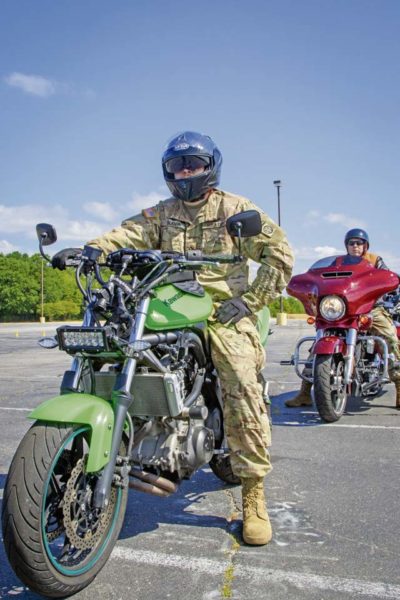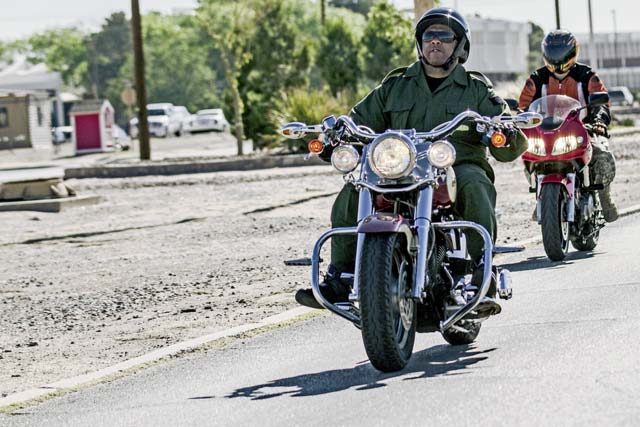
May is Motorcycle Safety Month and with that is the start of summer riding, great travel and touring opportunities that living in Europe has to offer.
Keeping that in mind, let’s talk safety. According to the National Highway Traffic Safety Administration, motorcycle riders are 27 times more likely to be killed in an accident than someone in a car. That’s why the U.S. Army Garrison Rheinland-Pfalz Safety Office compiled some helpful tips to make your ride safe and enjoyable this summer.
SHARE THE ROAD
We have all seen the bumper stickers on motorcycles, cars and trucks with the motto, “Share the Road.” But what does that mean? It means everyone who uses the road should drive responsibly and look out for each other. Small changes really make a huge impact when road conditions, traffic or weather change. Motorists must understand the safety challenges faced by motorcyclists such as size and visibility and motorcycle riding practices like downshifting and weaving to know how to anticipate and respond to them.
To put this into perspective — an adult on a motorcycle riding over 80 mph on the Autobahn is just as vulnerable as a child on a bicycle. If you were driving a car beside a child riding a bicycle on the street, you would drive cautiously and try to anticipate the child’s sudden movements. You should do the same for motorcycle riders — be cautious and give them some space. If you are a motorcycle rider, practice defensive driving because vehicle drivers may not see you or be paying attention.
GETTING ROAD READY IN GERMANY
Americans who want to ride in Europe must have a state endorsement for motorcycles on their driver’s license. This is a requirement to ride in Europe.
Army Motorcycle Safety Courses are offered at Kapaun Air Station and U.S. Army Garrison Wiesbaden. Riders can register on a government computer at the U.S. Army Installation Management Command Traffic Safety Training website: https://imc.army.mil/airs/usg_disclaimer.aspx.
Loaner bikes, helmets and gloves are available for free use during the basic rider course. Participants must show up with long-sleeve shirts, long pants and proper heavy-duty foot wear (military boots are fine).
PRE-RIDE CHECKLIST
Check the tire pressure and tread depth.
Check the hand and foot brakes.
Operate your headlights to ensure they are clear, bright and pointed in the right direction (most states require you can see an object 200 feet away and have the lights pointing at an angle 7 feet right of the center line 100 feet away).
Check your indicator lights for operation.
Compare your fluid levels to previous rides and top them up when necessary.
Check under the motorcycle for signs of oil or gas leaks.
Ensure if you are carrying cargo that it is secured and the load is balanced. Adjust the suspension and tire pressure to accommodate the extra weight, if necessary.
These are just a few of the checklist steps. View the full checklist at this link: https://safety.army.mil/OFF-DUTY/PMV-2/PamphletsChecklists.aspx

PERSONAL PROTECTIVE EQUIPMENT
Dress for the crash, not the ride. Wearing a U.S. Department of Transportation-approved helmet is the best protection for your head in a serious motorcycle crash. Look for the DOT symbol on the outside back of the helmet. Some motorcycle helmets include plastic face shields offering protection from wind, rain, insects, dust and stones. You can wear goggles if your helmet doesn’t have a face shield.
Be sure your arms and legs are completely covered when riding a motorcycle — wearing leather or heavy denim is ideal. Not only does protective gear shield you during a crash, it also helps prevent dehydration. Shoes or boots should cover your ankles and wearing gloves will protect your hands while giving you a better grip. Also, wear brightly colored clothing with reflective material to make you more visible to others on the road — especially at night.
Summer riding can be exhilarating and relaxing, just ensure you protect yourself by wearing the right gear, ensure your bike is in good working condition and keep your head on a swivel — and as always — never drink and ride.


